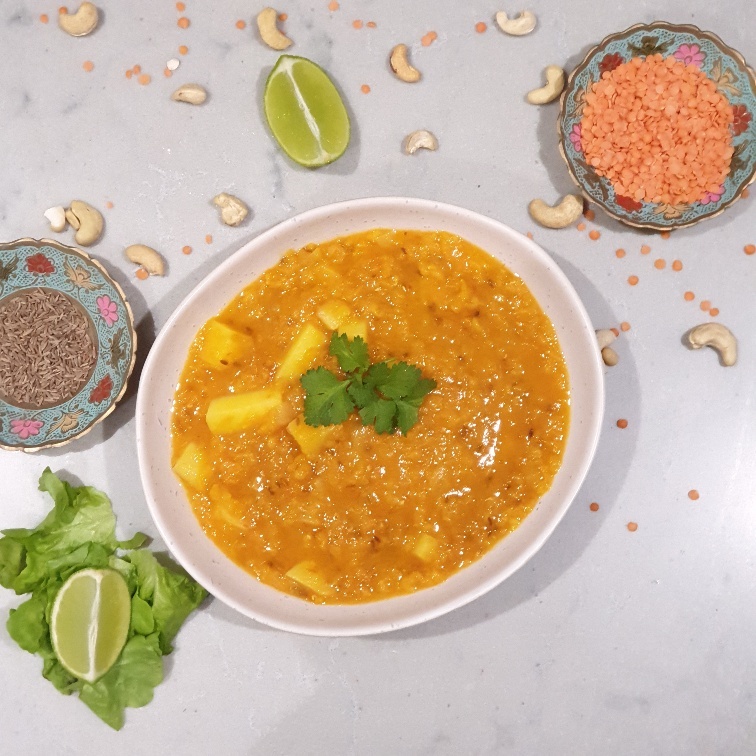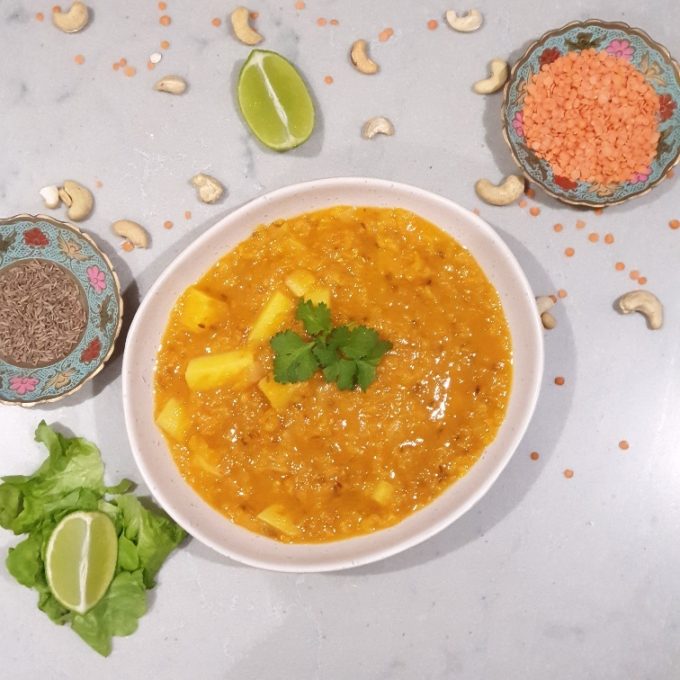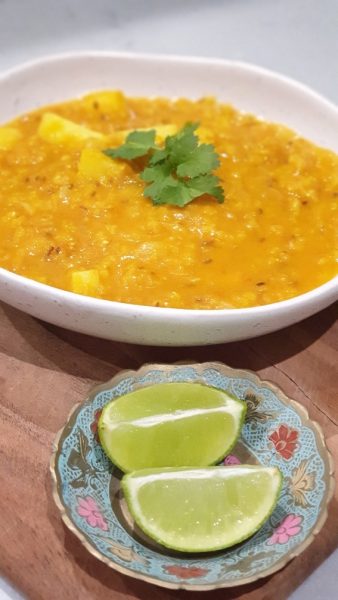Coconut Lentil Dhal

This is the very first Indian dish I learned to cook! My love for Indian cuisine was a slow burn, not love at first sight. Growing up in a traditional Italian family, the flavours I was familiar with included tomato, basil, rosemary, and parmesan cheese. Exotic spices and heat were entirely new to me.
When I met my husband, who is Indian, 26 years ago and had dinner at his family home for the first time, it was a cultural shock. It took some time to adjust my palate, but eventually, I began to appreciate and enjoy the complex flavours. This dhal recipe was the first Indian dish I truly enjoyed because it was mild in terms of spices, and the coconut cream added a rich, creamy texture that softened the intensity of the flavours.
Now, this dish is on repeat in our home. I love making it with extra vegetables—in this case, broccoli. It’s also great with potatoes and zucchini. When I crave something lighter, I prepare it without the coconut cream, making it subtle yet still nourishing. This recipe represents a beautiful fusion of my Italian roots and the Indian flavours I’ve grown to love.
Coconut Lentil Dhal

Ingredients
- 2 tablespoons olive oil
- 1 brown onion (diced)
- 2 teaspoons cumin seeds
- 3 cloves garlic (minced)
- 4 cm knob ginger (grated)
- 1 teaspoon coriander powder
- 1 teaspoon turmeric
- 1 teaspoon salt
- 3 tablespoons passata
- 1 1/2 cups orange lentils (rinsed until water runs clear)
- 1 large potato (diced)
- 4 cups water
Method
- Sauté onion in olive oil until
- Add cumin seeds and roast for 30 seconds with onions. Careful not to overcook as they will burn and turn bitter
- Add garlic and ginger, cook another 2 minutes.
- Turn down heat, add coriander, turmeric, salt and passata and cook two minutes to form a fragrant paste.
- Add lentils, potato and water and cook 20 minutes. As lentils begin to absorb the water, if they are not cooked at 20 minutes and the dhal is thick add some more hot water.
Recipe Notes
Equipment
- Saucepan
- Garlic mincer
- Wooden spoon

Orange lentils are a nutritional , containing about 25 grams of protein per 100 grams, which makes them an excellent source of plant-based protein. This high protein content supports muscle repair and growth, making lentils a great addition to vegetarian and vegan diets. In addition to protein, orange lentils are rich in essential nutrients such as iron, which is vital for transporting oxygen in the blood, and folate, which is important for cell repair. The presence of dietary fiber in lentils also supports digestive health, helping to maintain a healthy gut and prevent constipation.
Before cooking, it’s important to rinse lentils thoroughly until the water runs clear. This process helps remove any dirt or impurities that may be present on the lentils, ensuring a cleaner taste and better texture in the final dish. Properly rinsing the lentils is a simple but important step in preparing this dish, ensuring that it is not only delicious but also visually appealing.
In terms of serving suggestions, this dish pairs with various accompaniments. Basmati rice is a classic choice, providing a fragrant and fluffy base that complements the rich flavours of the dhal. The light and airy texture of basmati rice pairs perfectly with the creamy consistency of the dhal, creating a balanced and satisfying meal. Alternatively, Roti or Naan bread can be served alongside to scoop up the dhal, adding a delightful texture contrast. The soft and chewy texture of Naan or the thin and crispy Roti provides a satisfying counterpoint to the smooth and creamy dhal. For a more complete meal, consider adding a side of pickles or a fresh salad to balance the richness of the dhal and enhance the overall dining experience. A cucumber and tomato salad or a tangy pickle can add a refreshing burst of flavour and crunch to the meal, making it even more enjoyable.
The process of learning and perfecting this dish has deepened my appreciation for the diversity in food and has become a beloved staple in our family meals. Each time I cook it, I am reminded of the cultural blending and the personal growth that came with embracing new cooking traditions. Cooking this dish has not only been a way to explore new flavours but also a way to connect with my husband’s culture. The process of preparing dhal has become a moment of blending our backgrounds and creating something unique together. Sharing this meal with our family and friends has brought us closer and has allowed us to celebrate our diverse heritage through food.
To create a richer version of this dhal, you can substitute one cup of water with coconut milk. Adding the coconut milk about 10 minutes into the cooking process enhances the creaminess and richness of the dish, giving it a luxurious texture and depth of flavour. This simple modification can transform the dish into a more indulgent and comforting meal, perfect for special occasions or when you’re in the mood for something extra special. Enjoy!
Frequently Asked Questions
Do you have to use coconut cream?
Absolutely not, the recipe is the classic version without it but you can definitely add it in.
What other vegetables can you use?
Zucchini cut up into small pieces works well. Or add broccoli or cauliflower florets. If using broccoli add this towards the end of the cooking process so they remain a bit firm. Cauliflower can be added in early as it takes longer to cook than broccoli.
Any other lentils I can use?
Sure, at any Indian store you will find yellow dhal, mung dhal, and lots of similar small dhals. Orange is used mostly as it's the easiest to find in conventional supermarkets and usually the quickest to cook. If using different lentils you may need to keep an eye on the cooking process and add more water.
Do I have to add potato?
No, for a classic version, simply use lentils and no other vegetables.
Does this freeze well?
Yes, store in an airtight container, preferably glass. I don't recommend freezing the version with potato. Potatoes don't freeze so well.
Can I make a more mild version of this dish, especially for my children?
Yes, you can reduce the amount of cumin seeds and turmeric or leave them out entirely for a more subtle version
What can I use as a substitute for passata?
If you don't have passata, you can use canned crushed tomatoes or fresh tomatoes, diced as a substitute. Both will work well to create the base of the dish. The fresher the tomato the lighter the overall result will be, but equally delicious.

